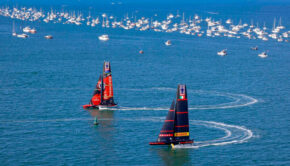How to Fix the World’s Most Prestigious Sailing Race
Published on July 7th, 2017
Angus Phillips was the outdoors editor of the Washington Post for 30 years, and remains a proud senior member of SINS, the Society of International Nautical Scribes, a group that historically holds just one beer-infused meeting every three or four years on the first lay day of the America’s Cup match, wherever it is. Angus shares his observations in The Weekly Standard.
As a reporter for the Washington Post, I covered every Cup from Dennis Conner’s successful defense in Newport, R.I., in 1980 to Larry Ellison’s weird win in Valencia, Spain, in 2010. I watched the America’s Cup sail off to Australia in 1983, come back in 1987, then go away again (to New Zealand) in 1995. I even sailed in some Cup trials, on Team New Zealand in 1995 and Ellison’s Oracle in 2000, as nonparticipating 17th man.
The most exciting events I saw were in 1983, when Australia II, the wing-keeled wonder from Down Under, beat Conner’s Liberty, 4-3, to end the New York Yacht Club’s 132-year stranglehold on the Cup, and 1987, when Conner went to West Australia in Stars and Stripes and won the “Auld Mug” back from a fleet of 16 other entrants in the wild winds and churning seas off beautiful, breezy Fremantle.
Those were drama-filled events that dragged on and on in grand, slow boats. The Cup summer of 1983 began in June and ended in September, and the Australian spectacle four years later started in October and ended in February. It meant months of intrigue, drama, and champagne-soaked social events that ink-stained wretches like newspaper reporters could only dream about the rest of their lives. What glamour!
The little whiz-bang Cup final in Bermuda in June lasted only 10 days and was laughable by comparison. The races were 20 minutes, so they could cram TV commercials in, and most of the time the boats were so far apart they couldn’t fit in the same frame. Was it cool to watch a sailboat go 45 miles an hour? Sure, for a little while—and if you call a 50-foot, hydrofoiling catamaran a sailboat.
I watched the first race of the 2017 America’s Cup at the Oar on Block Island, a sailor’s bar if ever there was one, where you can get a shower and a Narragansett draught for $5, all up. Patrons at the Oar can tie a bowline behind their backs. It was opening weekend of Block Island Race Week, and the place was jammed with yachties. But almost nobody was watching the sport’s premier event on the television, and the few that were had the same take: “I hope New Zealand wins.”
Well, the Kiwis did, emphatically. Now the hope is they will do the right thing and turn the Cup back into a sailing event instead of a crude reality-TV show. I’ll risk sounding like a fuddy-duddy: Bring back monohulls, and sailors in shorts and polo shirts.
I know scores of great sailors but I don’t know any that wear flak vests and helmets when they race, and none of them trims wings and underwater appendages with an Xbox. They don’t pedal a stationary bike to build hydraulic pressure when they go sailing or wear oxygen bottles on their back in case the rig comes down in a catastrophic crash.
The reason people love the America’s Cup, or used to, is that it embodies grace and style and glamour. It is wretched excess at its glorious best. The truest explanation of the Cup’s appeal was the following comment from Annapolis-based yacht designer Bruce Farr, who drew the lines for several Cup entries: “The America’s Cup isn’t about making money; it’s about spending money.”
That’s the charm. That’s what brought bigger-than-life figures like Harold S. Vanderbilt, Sir Thomas Lipton, Baron Marcel Bich, T. O. M. Sopwith, Bill Koch, and their pals to the game, along with the world-class sailors they hired, like Buddy Melges and Charlie Barr, Lowell North and Dennis Conner.
Why do people love Wimbledon, the Kentucky Derby, the World Series, the Olympics? Tradition. The grass courts were the same for Margaret Court, Martina Navratilova, and Serena Williams. The rackets are a little better, the costumes slicker, the athletes fitter, but the game is the same; the rules are the same.
The 1,500-meter Olympic final doesn’t get shortened to fit into a broadcast schedule, and a baseball game can still go on all night if nobody scores the winning run. A soccer field is 22 guys and a ball. Maybe some broadcast genius thinks it would be better if everybody could use their hands, or if the goalie could use a big fishing net. But they can’t.
The America’s Cup has painted itself into a silly little corner, playing to the fantasy that by abandoning the audience it built over 175 years, it can attract a new audience of couch-slouch thrill-seekers who get their kicks watching high-speed crashes on TV.
But the cup is in Kiwi-land now, the land of the long, white cloud, tucked away in Auckland, a seaside town that calls itself the “City of Sails.” These folks know what a sailboat looks like. Will they do the right thing? One can only hope.









 We’ll keep your information safe.
We’ll keep your information safe.